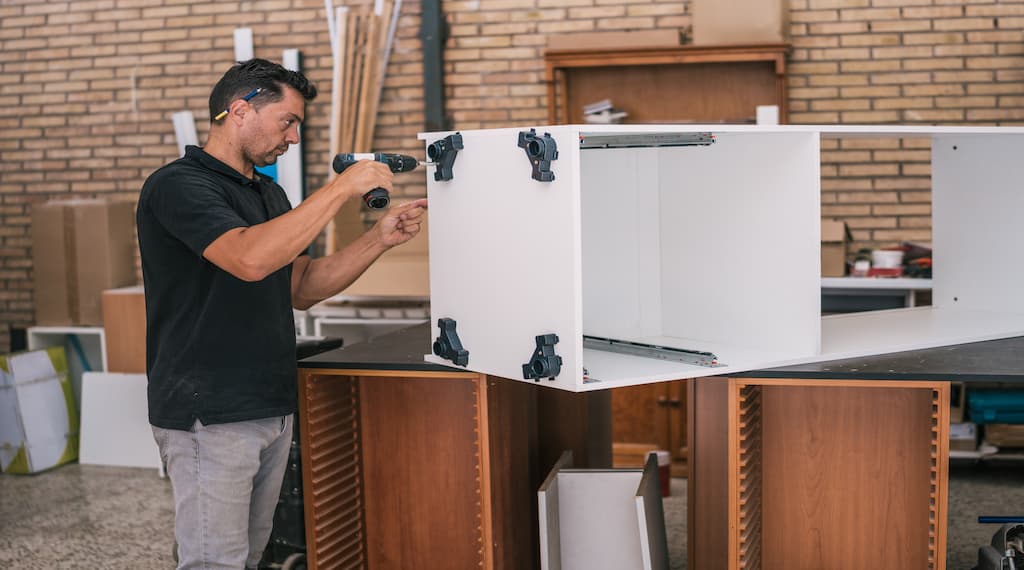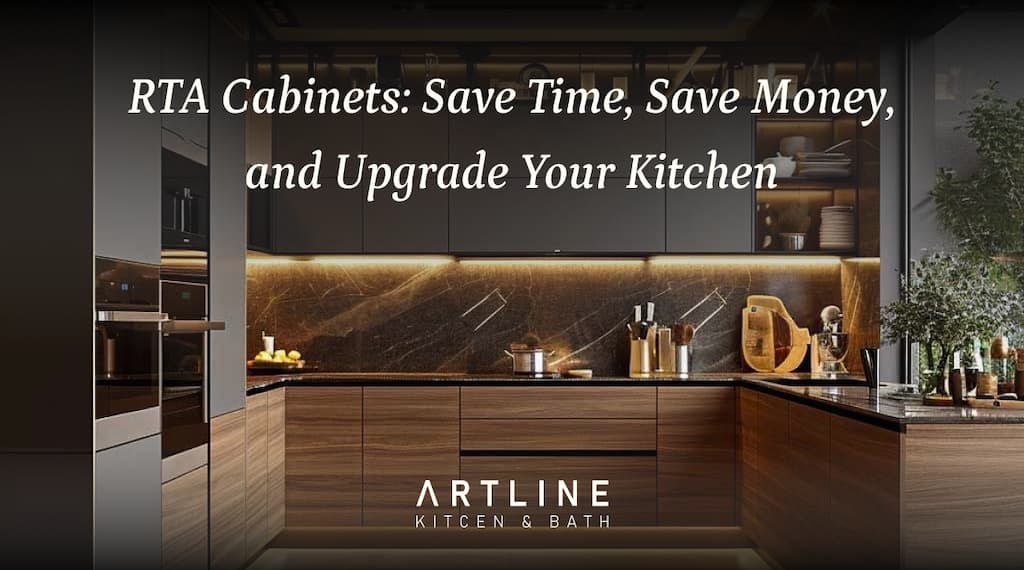RTA kitchen cabinets (Ready-to-Assemble kitchen cabinets) are an affordable, efficient option for homeowners looking to renovate on a budget or a tight schedule. Delivered flat-packed with all necessary components, they are assembled on-site, making them a popular choice for DIYers and contractors.
RTA cabinets typically cost less than semi-custom or custom cabinetry, ranging from $80 to $350 per linear foot. They are available in popular styles like shaker, slab, and raised panel. Material quality varies by brand, with higher-end options offering plywood construction, dovetail drawers, and soft-close hardware, while entry-level models may include MDF or particleboard.
While RTA cabinets lack the full design flexibility of custom options, they still offer a solid variety of finishes, hardware, and configurations, making them suitable for rental properties, small kitchens, secondary spaces, and budget-friendly remodels. They are available from big-box stores, online retailers, and manufacturer-direct platforms.
Assembly and installation are manageable with basic tools, and most homeowners can complete a standard kitchen within a weekend. However, RTA may not be the right fit for luxury kitchens or highly customized layouts.
Table of Contents
ToggleWhat are RTA Kitchen Cabinets?
RTA kitchen cabinets are ready-to-assemble cabinets shipped flat-packed for easy self-assembly and fast installation. Each unit typically includes the cabinet parts, hardware (such as hinges and screws), and clear instructions to guide the installation process.
RTA cabinets are mass-produced in standard sizes and styles, offering fewer personalization options but greater cost and shipping efficiency, unlike pre-assembled, semi-custom, or custom cabinets. They’re widely used in budget-friendly remodels, investment properties, and DIY renovations where affordability and quick turnaround are key.
How do RTA Cabinets Work?
RTA cabinets are shipped in flat boxes with all necessary parts, pre-drilled panels, hardware, and assembly instructions. The pieces are labeled and cut to fit together precisely, making the process manageable for homeowners, handymen, or contractors with basic tools.
Assembly usually involves the following steps:
- Unboxing and sorting components
- Using screws, dowels, cams, or brackets to join panels
- Attaching doors, hinges, and drawer glides
- Securing the cabinet to the wall during installation
Depending on the complexity and the person’s skill level, assembling one cabinet can take 15 to 30 minutes. Wall cabinets and base cabinets follow similar steps but may differ in mounting hardware or back panel design.
RTA cabinets work best when buyers are confident in their measurements, have a standard layout, and want to save on labor and delivery costs. For those less experienced with tools, hiring help for assembly and installation is also a common route.
What are the Benefits of RTA Kitchen Cabinets?
RTA kitchen cabinets offer an innovative combination of affordability, convenience, and modern style, making them an increasingly popular choice for budget-conscious homeowners and property investors.
- Lower Cost: Because they require self-assembly and ship flat, RTA cabinets cost significantly less than pre-assembled, semi-custom, or custom options. You save on both labor and freight.
- Fast Delivery: Most RTA cabinets are kept in stock and ship within 3–7 business days, making them ideal for quick renovations and projects with tight timelines.
- DIY-Friendly: RTA cabinets are easy to assemble for homeowners with basic tools and some patience. Clear instructions and labeled parts make the process straightforward, even for first-timers.
- Modern Designs at Budget Prices: Despite the low price, many RTA lines feature stylish finishes like white shaker, espresso slab, and navy blue, making it easy to achieve a high-end look without the high cost.
- Ideal for Small or Secondary Spaces: RTA cabinets work well in rental properties, basement kitchens, laundry rooms, and studio apartments, where fast installation and basic storage are all needed.
Drawbacks to Consider
While RTA kitchen cabinets are budget-friendly and convenient, they may not be the right choice for every kitchen project. Understanding the limitations can help you decide whether RTA is a good fit for your needs.
❌ Assembly Required: RTA cabinets arrive unassembled, so you’ll need time, space, and tools to assemble them. Assembly mistakes, such as misaligned parts or over-tightened screws, can affect cabinet durability and appearance.
- Basic tools needed: drill, screwdriver, level, wood glue, rubber mallet
- Limited Customization: RTA cabinets are produced in standard sizes and fixed styles, with little or no flexibility in sizing, layout, or features. They may not work well in kitchens with unusual dimensions or custom design needs.
❌ Durability Varies by Brand: Entry-level RTA cabinets may use lower-grade materials like thin particleboard or stapled joinery. Higher-end options use plywood boxes and dovetail joints, but quality can vary significantly between manufacturers.
❌ Time-Consuming for Larger Projects: While small kitchens or single-unit installs are manageable, assembling 10–15 cabinets for a complete kitchen can be time-consuming, especially without professional help.
Materials and Construction Quality of RTA Kitchen Cabinets
The durability and performance of RTA kitchen cabinets depend largely on the materials used and how they’re constructed. While some budget lines use entry-level components, many RTA cabinets offer surprisingly solid quality, rivaling more expensive options.
Common Materials in RTA Cabinets
- Plywood: Found in higher-end RTA cabinets, plywood is strong, moisture-resistant, and holds screws securely. Ideal for long-term use.
- MDF (Medium-Density Fiberboard): Smooth and great for painted finishes, but less moisture-resistant than plywood.
- Particleboard: A cost-effective option found in lower-end cabinets. Less durable and more prone to water damage.
Joinery and Box Construction
- Dowel and cam-lock systems: Common in mid-range RTA cabinets; easy to assemble and reasonably strong.
- Staple-and-glue: Quick but less durable, mainly seen in low-cost units.
- Dovetail drawer joints: A feature of better-quality RTA lines, offering long-lasting strength and a more premium feel.
Finishes
- Thermofoil: Durable and easy to clean, but can peel under high heat.
- Laminate: Scratch-resistant and affordable, commonly used in modern styles.
- Painted or stained wood: Available in premium RTA collections, offering a higher-end look and feel.
Popular Styles and Finish Options of RTA Kitchen Cabinets
RTA kitchen cabinets are available in a range of trendy and classic styles that can complement almost any kitchen design, from sleek modern spaces to warm farmhouse interiors. While the customization is limited compared to custom cabinetry, many RTA collections are designed to reflect current design trends.
Popular Door Styles
- Shaker: Clean lines with a recessed center panel; versatile and timeless, suitable for traditional and modern kitchens alike.
- Slab: Flat front with no detailing; perfect for minimalist or contemporary kitchens.
- Raised Panel: Adds depth and character; ideal for more traditional or formal spaces.
In-Demand Colors
- White: Still the top choice for clean, bright kitchens.
- Gray: Gray is a go-to neutral from light dove to dark charcoal.
- Espresso / Dark Brown: Adds contrast and richness, often paired with light countertops.
- Navy or Blue Tones: A bold, modern statement color growing in popularity.
- Natural Wood Finishes: Light oak, maple, and birch for a soft, organic look.
Finish Options
- Thermofoil: Smooth and affordable, available in solid colors or wood looks.
- Laminate: Durable, scratch-resistant, and easy to clean.
- Painted: Often on MDF doors; high-end look with more upkeep.
- Stained: Highlights wood grain for a natural appearance in wood-tone finishes.
How to Install RTA Kitchen Cabinets
Installing RTA kitchen cabinets can be a manageable DIY project, especially for homeowners who are comfortable with basic tools and instructions.
Step-by-Step Guide to Assembling and Installing RTA Cabinets
- Unbox and Organize: Lay out all cabinet pieces, hardware, and instructions. Group similar components together for easy access.
- Assemble Cabinets: Follow the included instructions using common fasteners like dowels, cam locks, screws, or brackets. Use wood glue for added strength if recommended.
- Measure and Mark Your Wall: Use a level to mark the wall’s cabinet heights and stud positions. First, begin with the upper wall cabinets to avoid working over the lower base units.
- Install Wall Cabinets First: Screw cabinets into wall studs, starting with a corner cabinet and working outward. Use shims to level as needed.
- Install Base Cabinets: Place and level each base cabinet before securing it to the wall and neighboring cabinets. Adjust legs or shims for uneven floors.
- Attach Doors, Drawers, and Hardware: Install doors and drawer fronts last, using adjustable hinges to align gaps. Add handles or knobs based on your template or preference.
ArtLine Kitchen and Bath Tips:
- Always double-check for level and plumb before anchoring.
- Assemble cabinets on a soft surface to avoid scratches.
- Use a stud finder to ensure secure anchoring to wall studs.

Are RTA Kitchen Cabinets Right for You?
RTA kitchen cabinets are a practical choice for many homeowners, but they aren’t right for every project. Understanding where they shine and where they fall short can help you decide if they’re a smart fit for your kitchen.
RTA Cabinets Are Ideal For:
- Budget Remodels: RTA cabinets offer one of the most affordable ways to upgrade a kitchen without compromising style.
- DIY Homeowners: If you’re comfortable with basic tools and instructions, RTA cabinets allow for hands-on savings and satisfaction.
- Small Kitchens or Secondary Spaces: Great for basements, rental units, guest apartments, or ADUs where fast, cost-effective solutions are needed.
RTA Cabinets May Not Be Ideal For:
- Luxury Kitchens: For homeowners who want premium finishes, custom trim, or furniture-grade cabinetry, RTA options may feel too limited.
- Complex Layouts: Kitchens with unusual angles or built-in appliances may require custom sizing that RTA cabinets can’t accommodate.
- Those Who Prefer Not to Assemble: While not difficult, assembly requires time, space, and attention to detail—not ideal for those seeking a hands-off solution.
RTA cabinets work best when affordability, speed, and simplicity are your top priorities. For high-end design or fully tailored spaces, semi-custom or custom cabinets may be a better fit.

FAQs About RTA Kitchen Cabinets
How long do RTA cabinets last?
With proper installation and care, RTA cabinets can last 10 to 20 years or more. Durability depends on construction quality, materials, and usage. Cabinets with plywood boxes and dovetail drawers tend to last the longest.
How do you install RTA cabinets?
RTA cabinets are assembled from flat-pack parts and installed by mounting them to wall studs using basic tools and careful leveling.
What are RTA cabinets made of?
RTA cabinets are typically made from a combination of materials, depending on the quality level. Most commonly, they feature:
- Solid wood or MDF doors and face frames
- Plywood or particleboard cabinet boxes
Some use laminate or thermofoil finishes, while others offer painted or stained wood options. Always check product specs for material breakdown.
Are RTA cabinets durable?
Yes, RTA cabinets are durable, especially when made from quality materials like plywood cabinet boxes, hardwood fronts, and dovetail joints. Durability depends on the brand, construction method, and how well they are assembled. While lower-end models using particleboard may wear out faster, well-constructed RTA cabinets can last 10–20 years or more with proper care.
Can I paint or refinish RTA cabinets?
Some RTA cabinets, especially those with unfinished wood or paintable MDF surfaces, can be painted or refinished. However, laminate and thermofoil finishes are harder to alter and may not hold paint well without special preparation.
Can stock RTA cabinets be modified?
Minor modifications, like trimming filler panels or cutting for plumbing, are possible. However, resizing cabinet boxes or altering the structure is not recommended, as it can weaken integrity and void warranties.
Do RTA cabinets come with instructions?
Yes, RTA cabinets come with detailed instructions and pre-drilled holes to simplify the assembly process.
Are RTA cabinets hard to install?
No, but they do require time, tools, and attention to detail.
Are RTA cabinets real wood?
It depends on the manufacturer and product line. Many high-quality RTA cabinets use solid wood doors with plywood cabinet boxes, while budget models may use MDF or particleboard. Always check the product specs for details on materials.
Are RTA cabinets the same as stock cabinets?
RTA (Ready-to-Assemble) cabinets are a type of stock kitchen cabinet, but they come unassembled and flat-packed, making them easier to ship and often more affordable.
Conclusion: Should You Buy RTA Kitchen Cabinets?
RTA kitchen cabinets offer one of the best combinations of affordability, style, and convenience in the cabinet market. RTA cabinets provide excellent value for homeowners focused on budget, quick delivery, or DIY installation, especially when made with durable materials and reliable joinery.
They’re ideal for budget-conscious remodels, small kitchens, rental properties, and secondary spaces. While they don’t offer the complete flexibility of custom cabinetry, RTA lines come in a wide range of on-trend styles and finishes that can enhance any kitchen without overspending.
Consider exploring RTA cabinet options from trusted suppliers or speaking with a cabinet expert to find the right line for your needs and timeline if you’re ready to start your cabinet project. With proper planning and installation, RTA cabinets can offer years of performance and appeal.

